Hawker Sea Fury Video - Low high speed pass
|
|
|
|
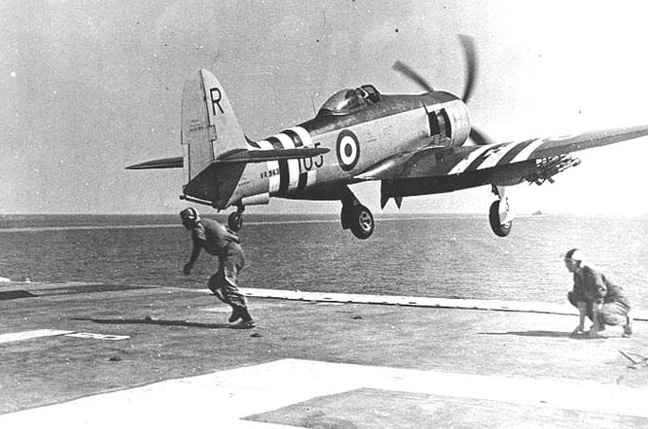 |
Crew: One Length: 34 ft 8 in (10.6 m) Wingspan: 38 ft (11.7 m) Height: 16 ft 1 in (4.9 m) Wing area: 280 ft² (26 m²) Maximum speed: 460 mph (740 km/h) at 18,000 ft (5,500 m) Cruise speed: 390 mph (625 km/h) Range: 700 mi (1,127 km) with internal fuel; 1,040 mi (1,675 km) with two drop tanks Service ceiling 35,800 ft (10,900 m) |
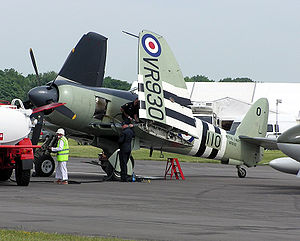 (Image: Hawker Sea Fury FB.11 VR930 with wings folded, at Kemble Airfield,
Gloucestershire, England. Operated by the Royal Navy Historic Flight.)
(Image: Hawker Sea Fury FB.11 VR930 with wings folded, at Kemble Airfield,
Gloucestershire, England. Operated by the Royal Navy Historic Flight.)
Role:
Naval fighter-bomber
Manufacturer: Hawker
First flight: 21 February 1945
Introduced: October 1945 (FAA), 1947 (RCN)
Retired: 1955 (FAA), 1956 (RCN)
Primary users: Royal Navy, Royal Australian Navy, Royal Canadian Navy
,Pakistan Air Force
Produced: 1945–1960
Number built: 860
Developed from: Hawker Tempest
The Hawker Sea Fury was a British fighter aircraft developed for the Royal Navy by Hawker during the Second World War. The last propeller-driven fighter to serve with the Royal Navy, it was also one of the fastest production single piston-engined aircraft ever built.
Design and development
The Hawker Fury was an evolutionary successor to the successful Hawker Typhoon and Tempest fighters and fighter-bombers of the Second World War. The Fury was designed in 1942 by Sydney Camm, the famous Hawker designer, to meet the Royal Air Force’s requirement for a lightweight Tempest Mk.II replacement. Developed as the "Tempest Light Fighter", it used modified Tempest semi-elliptical outer wing panels, bolted and riveted together on the fuselage centerline. The fuselage itself was similar to the Tempest, but fully monocoque with a higher cockpit for better visibility. The Air Ministry was sufficiently impressed by the design to write Specification F.2/43 around the concept.
Six prototypes were ordered; two were to be powered by Rolls Royce Griffon engines, two with Centaurus XXIIs, one with a Centaurus XII and one as a test structure. The first Fury to fly, on 1 September 1944, was NX798 with a Centaurus XII with rigid engine mounts, powering a Rotol four-blade propeller. Second on 27 November 1944 was LA610, which had a Griffon 85 and Rotol six-blade contra-rotating propeller. By now development of the Fury and Sea Fury was closely interlinked so that the next prototype to fly was a Sea Fury, SR661, described under "Naval Conversion." NX802 (25 July 1945) was the last Fury prototype, powered by a Centaurus XV. With the ending of the Second World War in Europe, the RAF Fury contract was cancelled and development centred on the Sea Fury. LA610 was eventually fitted with a Napier Sabre VII, which was capable of developing 3,400 to 4,000 hp (2,535 to 2,983 kW). As a result it became the fastest piston engined Hawker aircraft, reaching a speed of around 485 mph (780 km/h).
Naval version
In 1943, the design was modified to meet a Royal Navy request (N.7/43) for a carrier-based fighter. Boulton-Paul Aircraft were to make the conversion while Hawker continued work on the Air Force design. The first Sea Fury prototype, SR661, flew on 21 February 1945, powered by a Centaurus XII engine. This prototype had a "stinger"-type tailhook for arrested carrier landings, but lacked folding wings for storage. SR666, the second prototype, which flew on 12 October 1945, was powered by a Centaurus XV turning a new, five-bladed Rotol propeller and was built with folding wings. Specification N.7/43 was modified to N.22/43, now representing an order for 200 aircraft. Of these, 100 were to be built at Boulton-Paul.
Both prototypes were undergoing carrier landing trials when the Japanese surrendered in 1945, ending development of the land-based Fury; work on the navalized Sea Fury continued. The original order to specification N.22/43 was reduced to 100 aircraft, and the Boulton-Paul agreement was cancelled. At the same time construction of what was intended to be a Boulton-Paul built Sea Fury prototype, VB857 was transferred to the Hawker factory at Kingston. This aircraft, built to the same standard as SR666, first flew on 31 January 1946. The first production model, the Sea Fury F Mk. X (Fighter, Mark 10), flew in September 1946. Problems arose with damaged tailhooks during carrier landings; after modifications, the aircraft were approved for carrier landings in spring 1947.
Operational history
The Royal Navy’s earlier Supermarine Seafire had never been completely suitable for carrier use, having a poor view for landing and a narrow-track undercarriage that made landings and takeoffs "tricky". Consequently, the Sea Fury F.X (later F.10)replaced it on most carriers. Sea Furies were issued to Nos. 736, 738, 759 and 778 Squadrons of the Fleet Air Arm.
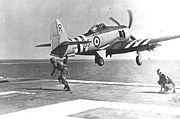 (Image: A Sea Fury FB.11 launches from HMS Glory in 1951)
(Image: A Sea Fury FB.11 launches from HMS Glory in 1951)
The F.10 was followed by the Sea Fury FB.11 fighter-bomber variant, which eventually reached a production total of 650 aircraft. The Sea Fury remained the Fleet Air Arm’s primary fighter-bomber until 1953 and the introduction of the Hawker Sea Hawk and Supermarine Attacker.
A total of 74 Sea Furies FB.11 (and one FB.10) served with the Royal Canadian Navy (RCN) between 1948 and 1956. All flew from the aircraft carrier HMCS Magnificent (CVL 21) in 871 squadron.
The last flights of the Canadian Sea Furies were made by Lieutenant Commander Derek Prout, who ferried WG-565 to Calgary, Alberta to serve as an instructional airframe at the local Provincial Institute of Technology, and F/O Lynn Garrison who flew WG-565 on 1 April 1958.
Korean War
The FB.11 served throughout the Korean War as a ground-attack aircraft, flying from the Royal Navy light fleet carriers HMS Glory, HMS Ocean, HMS Theseus, and the Australian carrier HMAS Sydney. On 8 August 1952, FAA pilot Lieutenant Peter "Hoagy" Carmichael Royal Navy downed a MiG-15 jet fighter in air-to-air combat, making the Sea Fury one of the few prop-driven fighter aircraft to shoot down a jet-powered fighter. Indeed, some sources claim a second MiG was downed, although most accounts do not mention this; either way, this is often cited as the only successful engagement by a British pilot in a British aircraft in the entire Korean War. The engagement occurred when his mixed flight of Sea Furies and Fireflies was engaged by eight MiG-15s, during which one Firefly was badly damaged while the Sea Furies were able to escape unharmed. A similar encounter the next day led to the Sea Fury fighters using their superior manoeuvrability to escape another MiG-15 "bounce" although one Sea Fury had to limp home to HMS Ocean.
Later service
 (Image:
Sea Fury T.20 two-seat trainer of No. 1831 Squadron RNVR at RNAS Stretton,
Cheshire, in 1951)
(Image:
Sea Fury T.20 two-seat trainer of No. 1831 Squadron RNVR at RNAS Stretton,
Cheshire, in 1951)
Sea Fury FB.11s entered service with the fighter squadrons of the Royal Naval Volunteer Reserve in August 1951. Units equipped were No. 1831, 1832, 1833, 1834, 1835 and 1836 squadrons, No. 1832 being last to relinquish the type in August 1955.
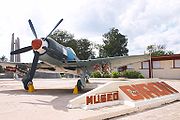 (Image: A Sea Fury F.50 preserved at the Museo Giron, Cuba)
(Image: A Sea Fury F.50 preserved at the Museo Giron, Cuba)
The Sea Fury F.50 export variant proved popular, being purchased by Australia, Germany, Iraq, Egypt, Burma, Pakistan and Cuba. The Netherlands bought 24 aircraft, then acquired a licence for production of 24 more F.50s at Fokker. Cuban Sea Furies saw action during the Bay of Pigs Invasion. The final production figures for all marks reached around 860 aircraft.
Variants
Sea Fury F.10
Single-seat fighter version for the Royal Navy.
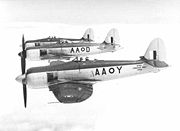 (Image: Canadian Sea Furies)
(Image: Canadian Sea Furies)
Sea Fury FB.11
Single-seat fighter-bomber for the Royal Navy, Royal Australian Navy and Royal Canadian Navy.
Sea Fury T.20
Two-seat training version for the Royal Navy.
Sea Fury F.50
Single-seat fighter version for the Royal Netherlands Navy.
Sea Fury FB.51
Single-seat fighter-bomber version for the Royal Netherlands Navy.
Sea Fury FB.60
Single-seat fighter-bomber version for the Pakistan Air Force.
 (Image: Pakistan Air Force Sea Fury T.61)
(Image: Pakistan Air Force Sea Fury T.61)
Sea Fury T.61
Two-seat training version for the Pakistan Air Force.
Fury I
Single-seat land-based fighter version for the Iraqi Air Force. Unofficially known as the Baghdad Fury, 55 built.
Fury Trainer
Two-seat training version for the Iraqi Air Force, five built.
Survivors
Because production continued until well after the end of the Second World War and aircraft remained in Royal Navy service until 1955, dozens of airframes have survived in varying levels of condition. A number of Sea Furies are airworthy today, with around a dozen heavily modified and raced regularly at the Reno Air Races as of 2006. Most of these replace the original sleeve-valve Centaurus radial, because rotational speed and tuning potential are limited in contrast to more conventional engines such as the Rolls Royce Merlin. Most racing Sea Furies use the Pratt & Whitney Wasp Major or the Wright R-3350 Duplex-Cyclone radial engine.
The Hawker Sea Furies were retired from service at about the same time the RCAF retired its Mustangs. Something like 46 Sea Furies were stored in a wooden World War Two hangar. Some had less than 4 hours total time - little more than factory test flights. As they were about to be sold to Lynn Garrison, and his associates, by Crown Assets Disposal Corporation, a fire destroyed the hangar and its contents. The aircraft were being offered to Ramfis Trujillo, son of the Dominican president, who was studying at America's Leavenworth Army School.
Many additional airframes remain as static displays in museums worldwide. One of these ex- RCN WG-565 is on display in Calgary, Alberta, Canada. It was ferried there for instructional use in the Alberta Provincial Institute of Technology by Lieutenant Commander Derek Prout. On 1 April 1958, Flying Officer Lynn Garrison, of 403 City of Calgary Squadron, RCAF, made the last military flight for this type in Canada.
Specifications (FB.11)
General characteristics
-Crew: One
-Length: 34 ft 8 in (10.6 m)
-Wingspan: 38 ft 4¾ in (11.7 m)
-Height: 16 ft 1 in (4.9 m)
-Wing area: 280 ft² (26 m²)
-Empty weight: 9,240 lb (4,190 kg)
-Max takeoff weight: 12,500 lb (5,670 kg)
-Powerplant: 1× Bristol Centaurus XVIIC 18-cylinder twin-row radial engine, 2,480 hp (1,850 kW)
Performance
-Maximum speed: 460 mph (740 km/h) at 18,000 ft (5,500 m)
-Cruise speed: 390 mph (625 km/h)
-Range: 700 mi (1,127 km) with internal fuel; 1,040 mi (1,675 km) with two drop tanks
-Service ceiling 35,800 ft (10,900 m)
-Rate of climb: 30,000 ft (9,200 m) in 10.8 minutes
-Wing loading: 44.6 lb/ft² (161.2 kg/m²)
-Power/mass: 0.198 hp/lb (441 W/kg)
Armament
-Guns: 4× 20 mm Hispano Mk V cannon
-Rockets: 12× 3 in (76 mm) rockets or
-Bombs: 2,000 lb (908 kg) of bombs
Source: WikiPedia